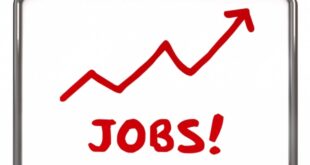The sector has been growing for 15 consecutive months, one of its longest streaks ever. One reason might be President Trump’s tax cuts, which appear to have increased the business community’s confidence in the economy.
Earlier this month, the Institute for Applied Research and Policy Analysis at Cal State San Bernardino published its Report on Business for the Inland Empire, something it’s been doing – for nearly 25 years.
The report, usually published on the first working day of every month, contains a breakdown of the manufacturing sector in Riverside and San Bernardino counties, with data on production, new orders, inventory, employment, supply deliveries and commodity prices.
It also asks the purchasing executives of Inland manufacturing companies how they expect the local economy to perform during the next three months, By implication, that provides a sense of how they expect their businesses to perform during that time.
But the most important data in the report is the purchasing managers index, which combines the data from the above-mentioned categories and determines whether the Inland Empire’s manufacturing sector is growing or shrinking.
The institute sends out approximately 60 questionnaires every month and usually receives 30 to 35 responses, said Barbara Sirotnik, institute director and a co-author of the report.
A score of 50 or more means the local manufacturing sector is expanding, less than 50 than it’s contracting. Three consecutive months in either direction establishes a trend.
Regarding the local purchasing managers index, the Inland Empire has been on fire of late.
The March number was 62.8, up from 59.1 in February, both numbers well above the 50-point benchmark. Moreover, the two-county region’s purchasing managers index has topped 50 for 15 consecutive months, not bad for a region better known for its warehouses and distribution centers than for producing goods and services.
“It’s definitely one of the longest streaks [above 50] that I’ve seen,” said Sirotnik, who was working at the institute in August, 1993, when the first index was published. “It’s also true that it doesn’t get above 60 very often.”
During its nearly 25 years in operation, the index has not been published only six times: In October and November 1996, July 2005 and July, August and September 2007, usually because of a temporary lack of funding.
The longest streak of 50 or above was 29 months, from December 1995 through April 1998. That assumes the index would have stayed above 50 during its two-month hiatus in 1996, which seems likely.
The index also stayed above 50 during the index’s first 21 months of publication, from August 1993 to April 1995, making the current streak is the third-longest on record.
It reached its highest point in May 2005, when it hit 64.1. During its entire operation – close to 300 published reports, as of this month – it has been at 60 or above 16 times.
The current streak will have to last for a little more than a year to surpass 29 consecutive months, and it’s difficult to predict the economy that far in advance. But, for the moment, the index shows no sign of dipping below 50.
As it often does, the Inland Empire is performing along the same lines as the national economy.
Last month, the national purchasing managers index was 59.3, the 107th consecutive month that U.S. manufacturing, and the economy, grew.
The national index is virtually identical to the report produced by the institute at Cal State San Bernardino. It’s produced by the National Institute of Supply Chain Management in Tempe, Ariz., and is based on information taken from 200 to 300 manufacturers.
“Manufacturing moves up or down with the economy, and right now the economy is up so manufacturing is up,” Inland Empire economist John Husing said. “It’s that simple.”
One likely reason for the manufacturing uptick is the business community’s apparent embrace of the Trump Administration’s economic policies, especially the Tax Cuts and Jobs Act of 2017, which President Trump signed in December.
That measure reduced the corporate tax rate from 35 t0 21 percent and the top individual tax rate to 37 percent. It still has seven income tax brackets, but it has been criticized for being too tilted toward corporate tax cuts, which are permanent.
But businesses relish tax cuts, and Trump’s program is undoubtedly helping the economy, at least in the short term, Sirotnik said.
“The business community has a lot of confidence in Trump,” Sirotnik said. “They see him as a successful businessman, as one of their own, and they believe he knows what he’s doing. On the consumer side, I think a lot of people believe the tax cuts will help them in the long run.”
Business confidence is definitely up in the Inland Empire.
Thirty five percent of the purchasing managers surveyed in March said they expect the local economy to get stronger during the next three months, while 55 percent predicted it will stay the same.
Only 10 percent said they expect the Inland economy to weaken during that time.
“Manufacturing is up because the economy is doing better than most people thought it would, going back to the last election,” said Jay Prag, professor of economics and finance at the Drucker School of Management at Claremont Graduate University. “Our growth rate was slow but now it has sped up, and that is seeping into all parts of the economy.”
Trump’s threatened trade war with China is not likely to harm the current manufacturing boom because it’s just that, a threat, Prag said.
“It’s posturing,” Prag said of Trump’s threatened tariffs against China, a proposal he appears to be moving away from. “It’s something the administration is doing to get the attention of our trade partners. I don’t think it was ever anything more than that.”
 IE Business Daily Business news for the Inland Empire.
IE Business Daily Business news for the Inland Empire.


